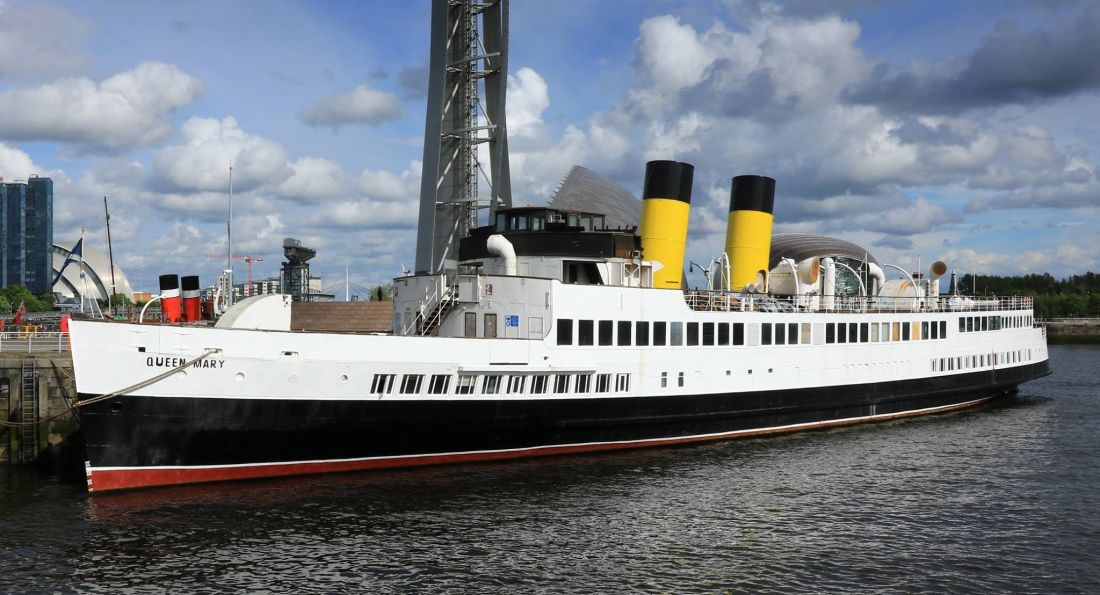
TS Queen Mary
part of the Clyde Turbine Steamers website from Gordon Stewart's paddlesteamers.info

Above : Queen Mary at Princes Dock basin, Glasgow, on 20th May 2017 (Photo by Kenny Whyte). With the air conditioning units and ice cream bar on the observation deck aft now removed she is now recognisably much closer to her 1948-1956 profile
A ship with a remarkable historical importance as the last survivor of her class worldwide : Queen Mary is one the finest excursion steamers ever built and was one of a fleet of steam turbine powered ships which brought a unique brand of speed, smoothness, quietness and a new level of comfort to day trips on Scotland's beautiful Firth of Clyde, sailing from 1933 until 1977. She was particularly associated with sailings direct to the Firth of Clyde from Glasgow city centre. She has a remarkable historical pedigree as yard-mate and fleet-mate of TS King Edward, the world's first passenger turbine ship and is now the last representative of this type anywhere in the world. Regrettably, her machinery was removed in 1988. Her contribution to the social history of the city of Glasgow is considerable and she has the added interest of being the ship which lent her name to the Cunard-White Star company for their iconic ocean liner in 1934 (see "A Ship With Historical Significance" below for more), sailing for most of her life as Queen Mary II.
For seven years her survival hung in the balance : After 20 years moored in central London and, it seemed, in the secure hands of a major brewing and hospitality company, the ship was put up for sale in 2008. With no buyers in the "trade", the local authorities gave notice on the lease for her berth at Waterloo Bridge to develop a pier for Thames waterbuses. Queen Mary was sold to a French businessman, Samuel Boudon, an executive in the luxury yacht-building sector who had hoped to establish her as a hotel and fitness centre in his home town of La Rochelle. Queen Mary languished at Tilbury and it became clear from the French end that the project could not be followed through on and the ship would need to be sold. At auction in August 2011 there were no buyers and she was at real risk of being scrapped until Ranjan Chowdhury subsequently stepped in to purchase her. Mr Chowdhury worked hard to try and find a future for her, but financing of such a project always appeared to be little more than a remote possibility. With no prospect of progress, he had no option other than to relinquish the ship in 2015. The Friends of TS Queen Mary, established in 2011 by enthusiasts who had been keeping an eye on the ship's plight since 2009 had, in the meantime, formulated a plan to preserve her under charitable ownership should she become available for sale. They were able to step in and their purchase of the vessel was announced on 25th October 2015.
THE FRIENDS OF TS QUEEN MARY - A SCOTTISH CHARITY AND NOW THE SHIP'S OWNERS
This organisation, which has charitable status, was established by a group of those who hoped that the ship could be returned to her home river, the Clyde. The charity trustees worked hard to ensure that a return to Glasgow would be possible if the ship was one again put up for sale, which in the absence of any apparent developments always appeared a strong possibility. Their aim is to see her established as an educational and historical attraction for the benefit of the city.
Charity Registered on 4th December 2012 : Number SC043623FOR NEWS, OFFICIAL INFORMATION AND INTERACTION WITH THE FRIENDS OF TS QUEEN MARY AND HER SUPPORTERS. Click below :
OFFICIAL WEBSITE and OFFICIAL FACEBOOK PAGE
SPECIFICATIONS AND HISTORY
Built in 1933 by Wm. Denny & Bros. at Dumbarton, Scotland (yard no. 1262)
Dimensions : 263 ft 4 in x 37 ft x 7 ft 6 in (80.26 m x 11.28 m x 2.29 m)
Engines : 3 direct drive turbines (1 x HP, 2 x LP also for reversing : 800 RPM 3800 - horsepower) (Removed, two preserved, third originally exhibited aboard)
Boilers : Scotch double-ended (as built) - replaced in 1957 with Yarrow water-tube oil fired boiler (Removed)
Gross Registered Tonnage : 870 (as built) then 1014 (after reboilering in 1957)
SERVICE
Early Years
- Built for
Williamson-Buchanan Steamers Ltd for their Clyde services from Bridge
Wharf, Glasgow
- Keel laid : 9th December 1932
- Launched : 30th March 1933,
naming ceremony conducted by Lady Colquhoun
- Trials : 15th May 1933, achieving
19.696 knots
- Entered service : 20th May 1933
- Understood to have cost
GBP 61,805 and 16/9d - equating to approximately GBP 3 million in currency terms
of 2010.
- Twin funnels exhausing a Scotch-type boiler were painted in
Williamson-Buchanan colours, white with black tops
- Unusually for a Clyde
Steamer, first class accommodation was at the forward end of the vessel (lounge
on promeande deck, restaurant on main deck)
- Normal weekday schedule
was to leave Glasgow at 10:00 hrs for Dunoon and Rothesay, with a range of onward
non-landing cruises
- Saturdays saw her leave Glasgow at 13:45 for Dunoon,
Rothesay and the Kyles of Bute
Renaming then joining the Caledonian
- Renamed Queen Mary II in 1935 to allow her name to be used for the
new Cunard-White Star liner.
- Presented with a portrait of HRH Queen Mary which hung
in the forward lounge by the Cunard company in appreciation
- Williamson-Buchanan (1935) Ltd established in October 1935
as her owners became a subsidiary of the Caledonian Steam Packet Co.
- Only
took the yellow and black funnel colours of the CSP in December 1939 and was
finally registered as owned by that company in 1943
Wartime
- Remained on the Clyde throughout the Second World War sporting a range of (mostly grey) camouflage liveries.
- Wartime
duties involved ferry work between Gourock and Dunoon and tendering military
and troop-transporting ships including RMS Queen Mary
Post-war
- Enclosed
wheelhouse fitted in 1948
- First and third class areas were abolished
in 1950 and all accommodation became available to all passengers
- Mainmast fitted in 1954 to meet new safety regulations - and new cafeteria facilities
installed in the same year
- Converted to an oil burning Yarrow water-tube boiler in early 1957 by Barclay, Curle. One large elliptical funnel
incorporating ventilation replaced her two funnels
- Radar installed in 1960.
-
Livery change in 1965 to "monastral" blue hulls of British Rail, but
retained the Caley's yellow funnel - albeit with red lions rampant
fitted to the sides
- Masts shortened in 1969
so that she could sail under the new Kingston Bridge on which a new motorway
ran through Glasgow
- After the 1969 season, Glasgow sailings from Bridge Wharf were withdrawn
(with the new bridge still unfinished) and she then sailed out of Gourock
- Black hull colouring restored in 1970
-
Extensively refitted and facilities rearranged in early 1971 and placed
on a wider range of excursion sailings following the withdrawal of TS
Duchess of Hamilton
- Lost
her (unreplaced) bow rudder in a collision with US navy tug Natick in July 1972 in fog off the
Cloch - sailed for the rest of the season with
twisted bow plates
-
Funnel repainted in Caledonian-MacBrayne red (incorporating the
yellow disc and red lions rampant of the CSP) for the 1973 season
Back to her old name for two seasons
- Her original name was restored in 1976 after Cunard's Queen Mary was removed
from the register.
- In 1976, sailings to and from Glasgow (which had proven popular with passengers of the paddle steamer Waverley) were
restored
-
Withdrawn in 1977 having had poor loadings and after local government
tourist development grants were withdrawn in favour of the
Waverley.
- Her final cruise was an
evening "Showboat" cruise from Largs to Rothesay and through the Kyles
of Bute on September 12th 1977.
- Earlier that day she had sailed light from
Gourock to Largs then took a public cruise via Rothesay and Dunoon into Loch
Long then back light from Largs to Gourock
- Laid-up at East India Harbour, Greenock
.
PRESERVATION
Greenock
-
Short-lived informal enthusiast group Friends of Queen Mary established
(Note : no connection with the current Friends' charity)
- Sold to Glasgow District Council in June 1978 for GBP 30,000
- Plans to develop her as a maritime
museum
on the Clyde collapsed as budgets were cut by a new incoming government.
- Sold to Euroyachts Ltd for use as a floating restaurant at Anderston Quay, Glasgow,
for GBP 17,000 in May 1980
- Without progress, the National Trust for Scotland showed interest in the ship for use as offices and an educational centre
- In 1981, after eight months with Euroyachts she was sold to
the Lau family restaurant company Tesright Ltd for
GBP 40,000
London Docklands
- Left the Clyde on 29th January 1981 under tow to King George V Dock,
London, arriving on 2nd February. The tug was MV Pullwell Delta
- Damaged by fire during refitting. Laid up.
- Sold to brewers Bass-Charrington (Toby Restaurants Division) in 1987 to replace her former Clyde fleetmate PS Caledonia,
which was lost to fire in 1980.
Chatham Dock
- Refitted by the Crescent Shipyard Co, at Chatham No2 dock arriving on 28th December 1987.
- Fully stipped down and opened out. Fitted with new funnels, masts, companionways and
bulkheads. The total cost was estimated at GBP 2 million
- Warren Smith Architects involved in the design work.
- Moved from
Chatham Historic Dockyard on
July 29th 1988 under tow by Warrior (skippered by Ron Livett), Triton and Sir Aubrey of
Warrior Towage Ltd.
The Embankment, London
- Moored alongside the Embankment on the north bank of
the Thames immediately upstream from Waterloo Bridge with her bows pointing
upstream
- She was understood to have been the largest vessel to have reached
this far upstream
- Soon after arrival
her white and black funnels aquired two red bands separated by a white band
with a thin black line around the centre of the white band.
- Received a major refurbishment in 1997 at Chatham at a reported cost of GBP
2.5 million and reappeared with buff funnels with black tops.
- In 2005 her
upper works were painted light blue, her ventilators being buff to match the funnel
- In February 2006 the blue was overpainted with brilliant white. White funnels with black tops were restored, now
featuring a "QM" inscription
- Unsuccessfully offered for sale in the licensing trade as a going concern (including berthing rights) in 2008 - original asking price £ 249,500
-
City of Westminster Council exercised a 6-month notice period on the
lease to develop Thames riverbus service facilities at Savoy Pier
- Closed for business in January 2009
- Reoffered for general sale with requirement to remove the vessel at price of £ 154,950
- Sold to a private consortium headed by Mr Samuel Boudon with
plans to convert her for use as a floating
hotel at La Rochelle, France.
Tilbury Dock
- Left London for Tilbury Dock under tow by the tug Aicirtron (again skippered by Ron Livett) assisted
by Horton and Unico on 9th November 2009
- By the summer of 2011 the La Rochelle project was cancelled and the ship remained
laid-up at Tilbury as the owner unsuccessfully sought to negotiate a sale
- Auctioned
at short notice in August 2011 with guide price of £ 150-200,000 but failed to sell
- Sold by negotiation to a UK-based private buyer, Ranjan Chowdhury, in September 2011.
- Purchased
by the Scottish charitable organisation Friends of TS Queen Mary in
October 2015 for a reported sum of £ 20,000
-
A public appeal was launched to allow her to be made fit for and to
finance a tow to Scotland, where her permanent home is planned to be
Greenock & Glasgow
- Left Tilbury under tow of tug Venture of the Carmet Tug Company under captain Brett Metcalfe on May 11th 2016
- Arrived at James Watt Dock, Greenock, on May 15th, 2016 assisted into the dock by Clyde Marine Services' Bruiser and Battler
-
After a further fundraising appeal, she entered dry dock in Greenock on
September 1st 2016 for full attention to her hull and painting of her
hull and upperworks
- Returned to the James Watt dock alongside the dry dock on October 1st 2016
-
Towed to Glasgow for winter lay-up in the Princes Dock basin behind the
Science Centre on 9th November 2016
-
Funnels painted yellow with black tops (Feb 2017) to reflect earlier
CSP Co. colours. Overpainted with buff shade at end of Aug 2018
after criticism of the yellow shade
-
Physical work undertaken to strip out redundant fittings and the
coverings of the teak decks (dating from the 1997 refit) removed
-
On going work to restore or replace degraded parts of the ship's fabric
including restoration of the teak decking and new promenade deck windows
- On March 11th 2019 it was announced that HRH The Princess Royal had become the Royal Patron of the charity
- On June 6th 2019 she was towed to Greenock for a dry-docking
-
On March 11th 2022 HRH the Princess Royal, visiting the ship,
told assembled guest was that the plan was now to return the ship
to active service as a cadet ship
-
In 2023 the ship was moved across the neck of the Princes Dock basin to
a berth alongside the Govan Graving Docks for major renovation works to
commence following an anymous donation of £ 1 million
- On June 8th
2023 the funnels were removed as the first visible stage of this
renovation. They will be replaced by funnels of the original size and
rake as built in 1933
A SHIP WITH HISTORICAL SIGNIFICANCE .........
A genuine "last of" : The importance and uniqueness of ships can often be overstated
and it is wrong to make too many claims to fame for any ships, but in the 21st
century we are now seeing quite a few "last ofs" and Queen Mary
can claim one of these as well as a strong direct link to a fleet-mate which
really was a "first of" of her type worldwide
- Direct derivative and fleet mate of the world's first ever steam turbine powered passenger ship,
TS King Edward (1901-1951).
- The last passenger-only turbine steamer in operation built as a coastal and estuarine day excursion ship
- The last surviving example of her class worldwide and one of the few remaining examples of a passenger ship of any class built with steam turbines
Please
note that steam turbines became widely used in marine engineering,
particularly short-sea ferries, ocean liners and military ships
- examples of which survived in survice long after Queen Mary
was decomissioned. However, no passenger ships now survive in service
anywhere
The "original"
Queen Mary : Although not the first ship to have been called Queen Mary, she has the curiousity value of holding the name that
the Cunard-White Star line needed for its new ocean liner, which went on to become one
of the world's most famous ships. The grudging agreement of her owners saw the name go to the Clydebank-built
liner so as to avoid an unacceptable duplication of names on the shipping register. The liner
is now preserved in Long Beach, California, whilst the Clyde steamer
became "Queen Mary II" until recovering her original name in
1976. On display in her forward saloon
was a
portrait of HRH Queen Mary, wife of HRH King George V, gifted by the Cunard
company in appreciation. In addition, a brass plaque was presented which recorded
the details of the event.
Click
here for more
about Queen Mary's connection with the famous Cunard ocean liner
Queen Mary
Queen Mary's importance to the social history of Glasgow and the Firth of Clyde should not be underestimated. She was primarily based in the centre of Glasgow, ferrying many hundreds of thousands of its citizens to the Clyde resorts for day trips and for their annual holidays. Going "doon the watter" was one of the timeless aspects of industrial Glasgow's life - a rare chance to escape the city for the fresh air and beautiful scenery of the Firth in a ship built in one of the area's most famous shipyards.
Queen Mary's original owner, Williamson-Buchanan Steamers Ltd was formed by the amalgamation two private fleets and dominated sailings to the Clyde resorts from the heart of the city of Glasgow (with calls normally at Govan and Renfrew in pre-second world war years). It was a longer sail but at a cheaper price than the steamers owned by the railway companies which connected with their rail services to piers on the Clyde coast. Queen Mary was remarkable to the extent that she brought unheard-of luxury to this service because "all-the-way" boats from Glasgow had tended to be utilitarian. She took the prime cruise roster, relegating the pioneering turbine steamer King Edward (of 1901, a flyer for sure, which was acquired in 1927 for this service) to the later Kyles of Bute run, with a number of older paddle steamers providing additional runs to Dunoon and Rothesay.
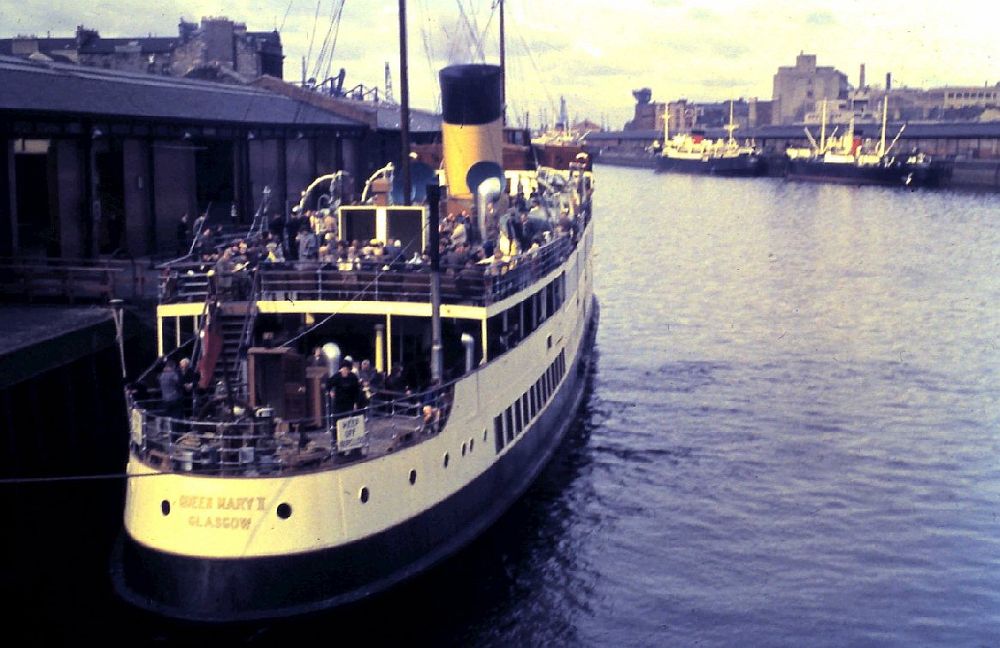
Above : For much of her career, Queen Mary (II) sailed from Bridge Wharf on the south bank of the Clyde not far from the city centre. The Clyde was a working river with busy shipyards, quays and warehousing. In the photo taken around 1960 and kindly supplied by Gillon Ferguson this can be clearly seen as the river is lined by warehouses and Bridge Wharf hardly looked like an attractive departure point for tourists. In the mid 19th century the river was severely polluted, but by 1960, the health hazards once facing passengers were no longer a problem and the upper part of the river still had much of interest to see as the ship sailed towards more attractive scenery.
Below : Even in the 1970s there were occasions when the crowds thronged the ship although the car-ferry links to Rothesay were better than ever and in her final years, as Cal-Mac's last remaining traditional cruise ship, she saw further-flung piers more frequently than she had done in her heyday. However, at the end of the 1969 season, sailings from Glasgow were abandoned and not reintroduced until 1976. In this view by Kenny Whyte it was the Bute Highland Games which brought the trippers out in such numbers. Rothesay and trips "doon the watter" remained popular but the costs of running and maintaining a large ageing steamship began to weigh increasingly on hard-pressed finances at Caledonian-MacBrayne - and despite all expectations, paddle steamer Waverley, independently owned after her withdrawal at the end of the 1973 season, returned to service in 1975 to chase a share of the business - and for two seasons (1976 and 1977) both Queen Mary and Waverley fought for customers from Glasgow.
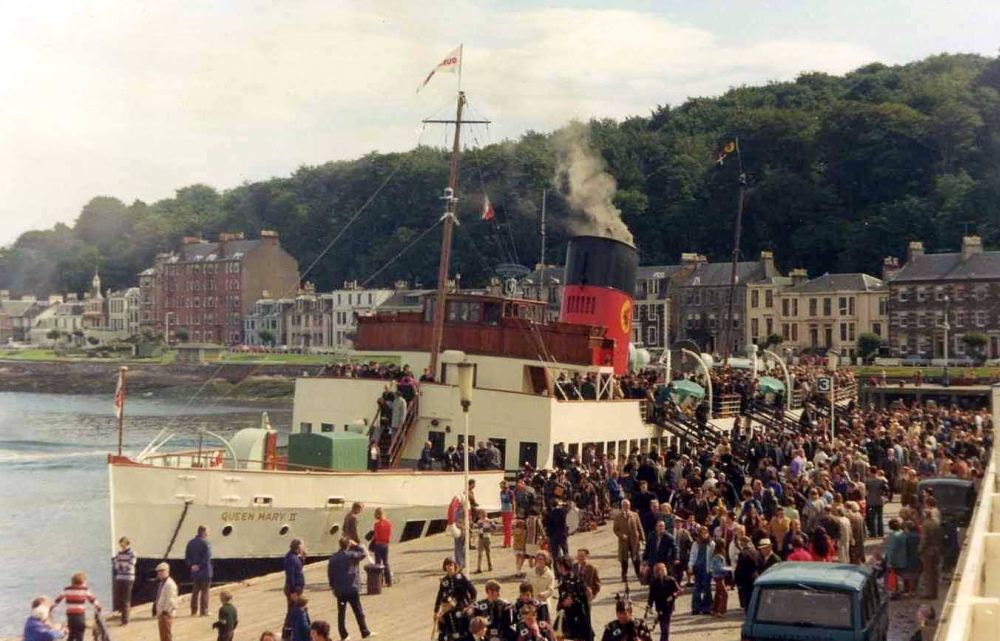
IN PHOTOS : QUEEN MARY FROM 1933 UNTIL THE PRESENT DAY
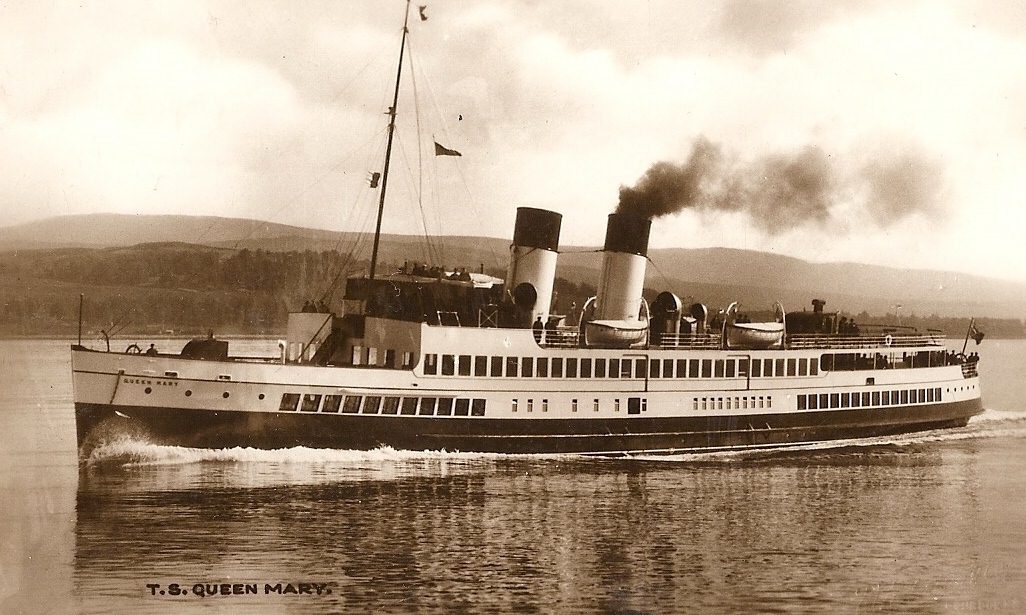
At the
end of 1935 this hitherto independent company, itself a merger of two private
fleets, was absorbed by the Caledonian Steam Packet Company, the subsidiary
of the London, Midland and Scottish Railway. From 1936 until 1943, the Williamson-Buchanan
vessels remained in a CSP subsidiary, Williamson-Buchanan (1936) Ltd.
As
Williamson-Buchanan had no connection with the railway companies whose fleets
dominated the Clyde and owned the piers with railheads, they had traditionally concentrated on "all-the-way"
sailings to the coastal resorts from Central Glasgow - a longer day out, but
traditionally cheaper for passengers. Queen Mary brought unheard of luxury to
what had traditionally been the poor relation of Clyde services and remained closely associated
with this route throughout her career.
Above : Post card view, possibly showing the ship undergoing her official trials, courtesy of Gillon Ferguson
Read
Gordon Stewart's review of Clyde Steamers in the 1930s and see how
Queen Mary fitted into the busy ferry and excursion trade of that decade - here
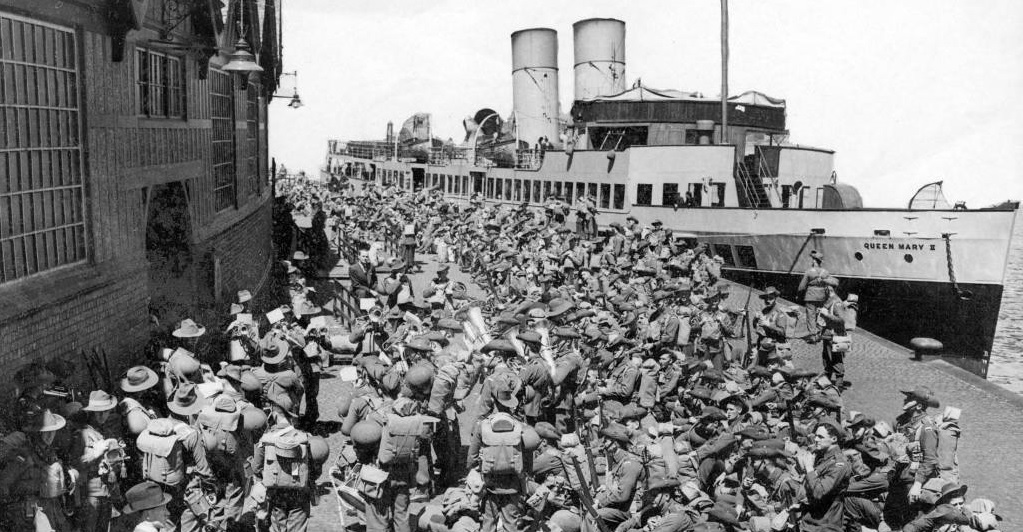

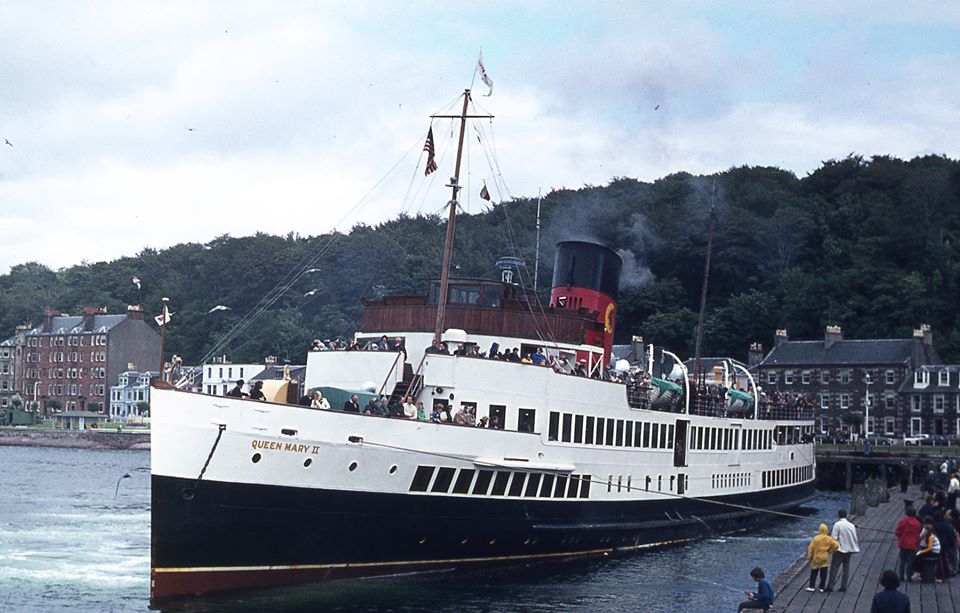
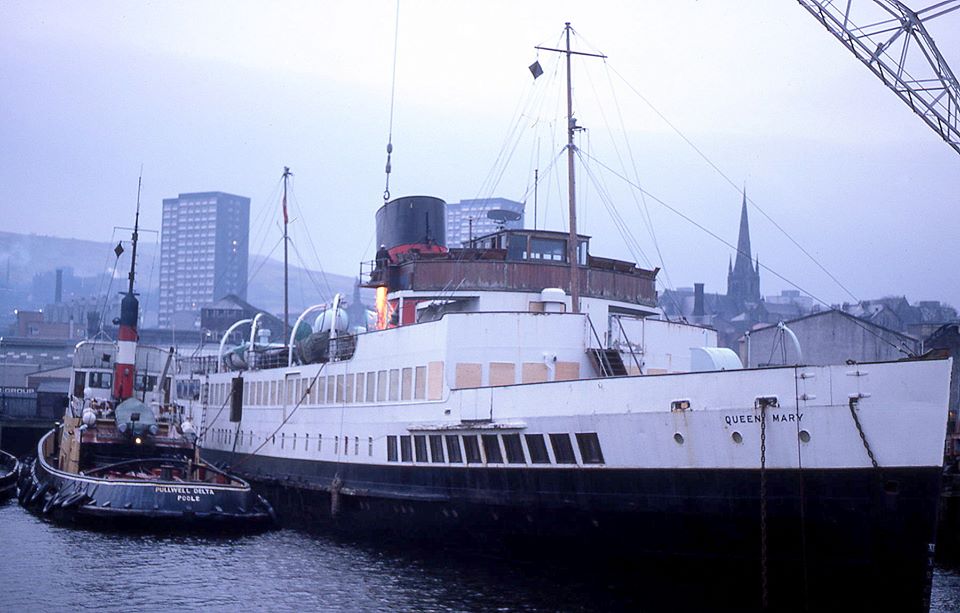
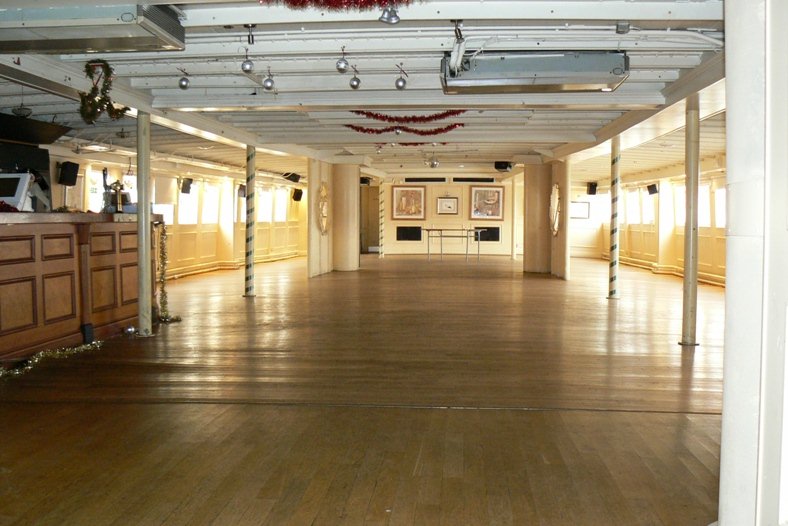
With
little chance of her being retained as a pub and her valuable berth
eyed for new river bus developments, Queen Mary was advertised through
a ship-broker (Capital Boats) and immediately attracted interest. How much was genuine
and how much was just sentimental enquiries is unknown, but in April
2009 it became clear that she was destined to be sold to French
interests. It then became known that she was bought for conversion
to a hotel ship and would be moored in the marina at the French
port of La Rochelle. She was closed for business in January 2009 and cleared of most of her furniture and fittings
Photos
by kind courtesy of Richard Lane of sales agents and auctioneers,
Capital Boats / Capital Marine Auctions

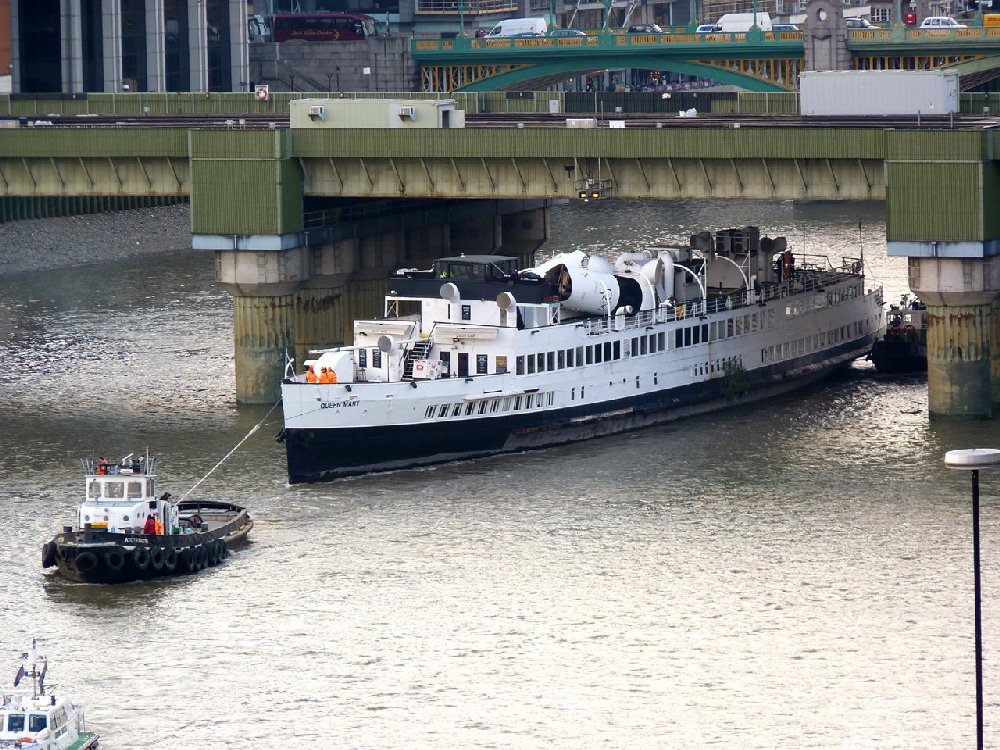
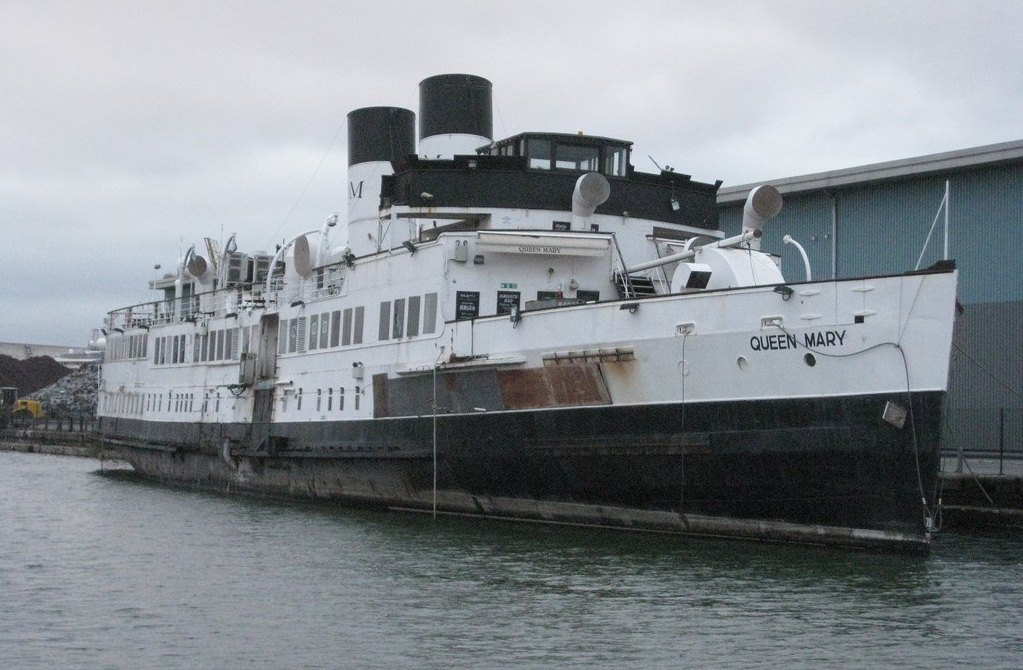
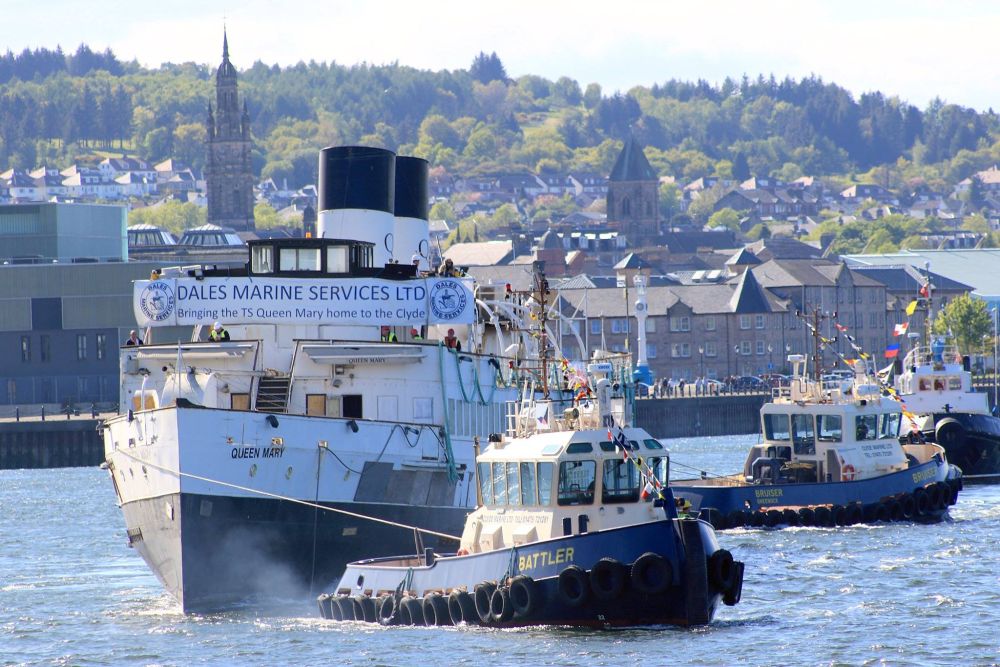
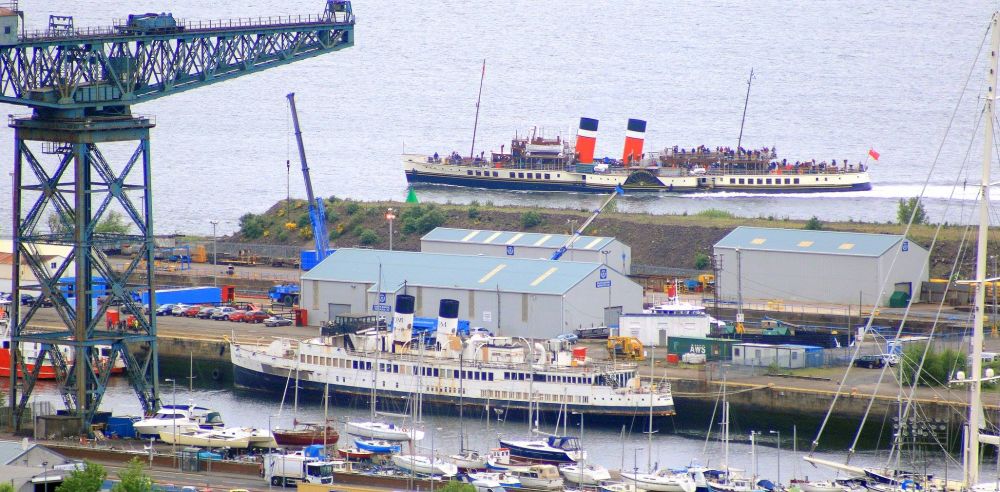
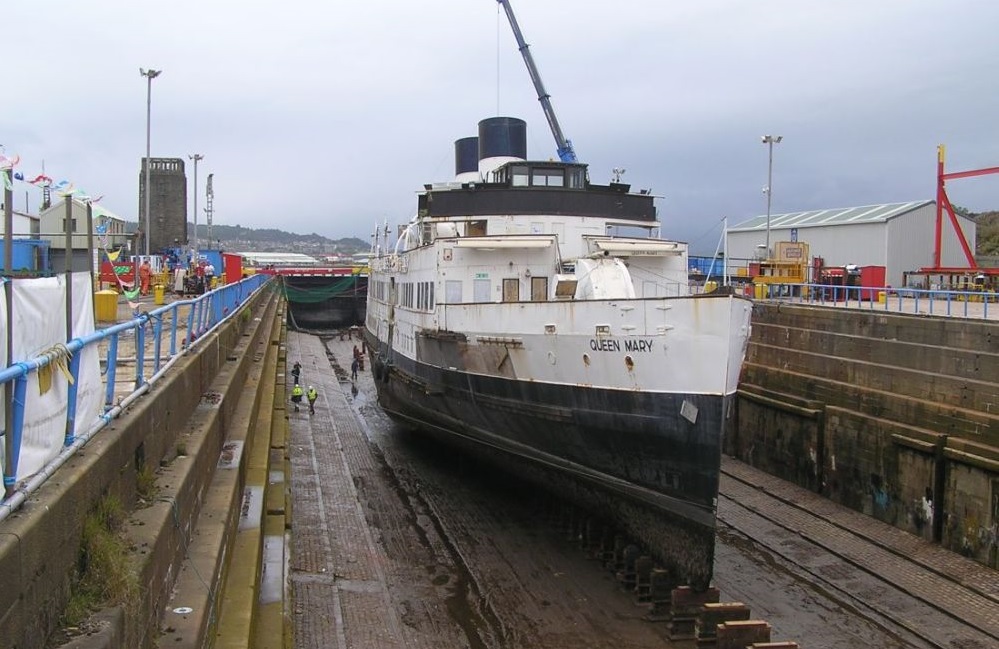
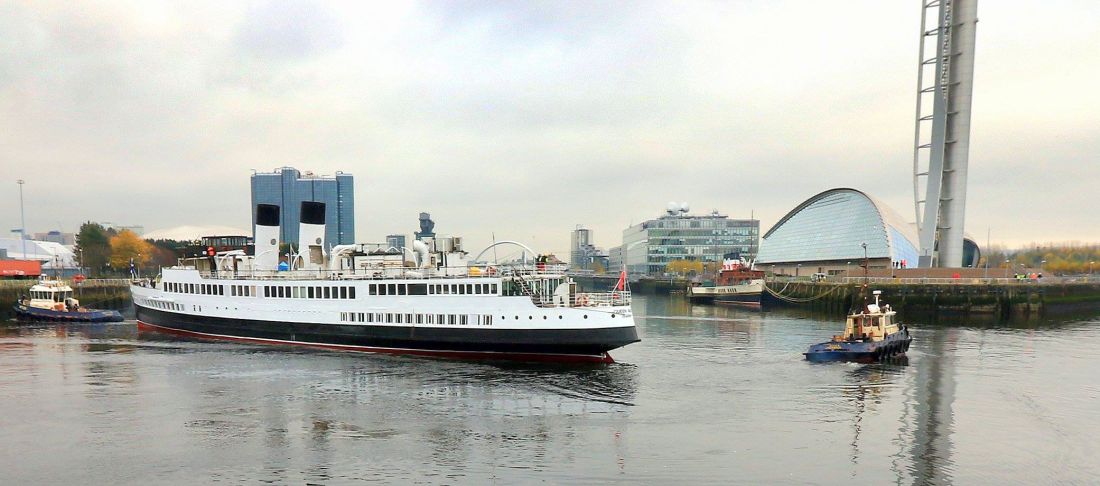
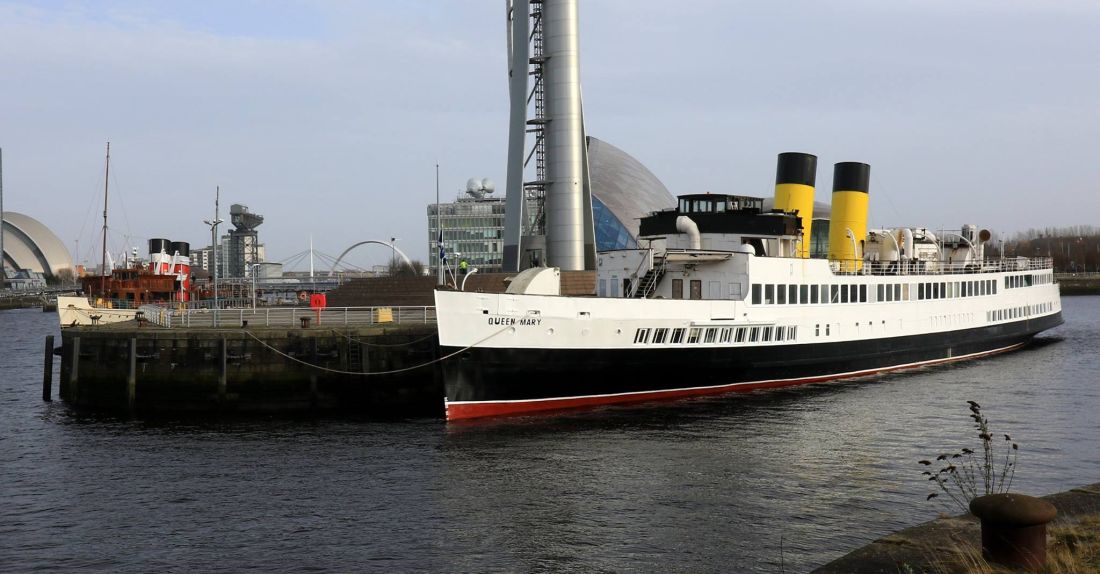
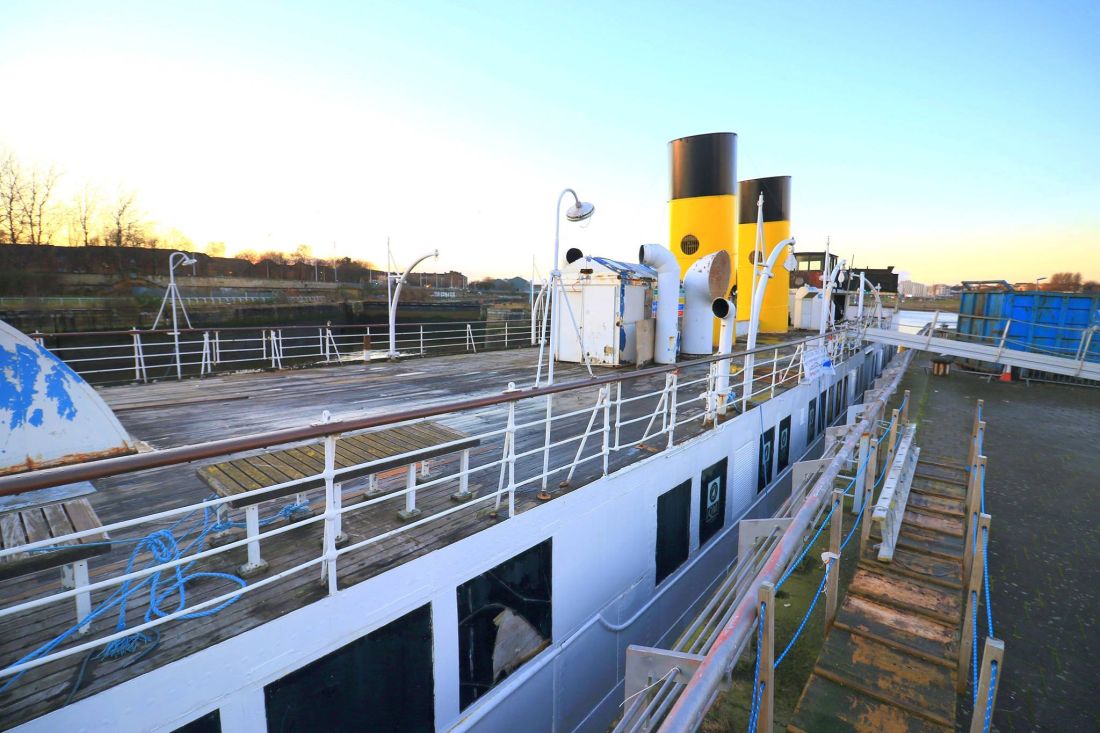
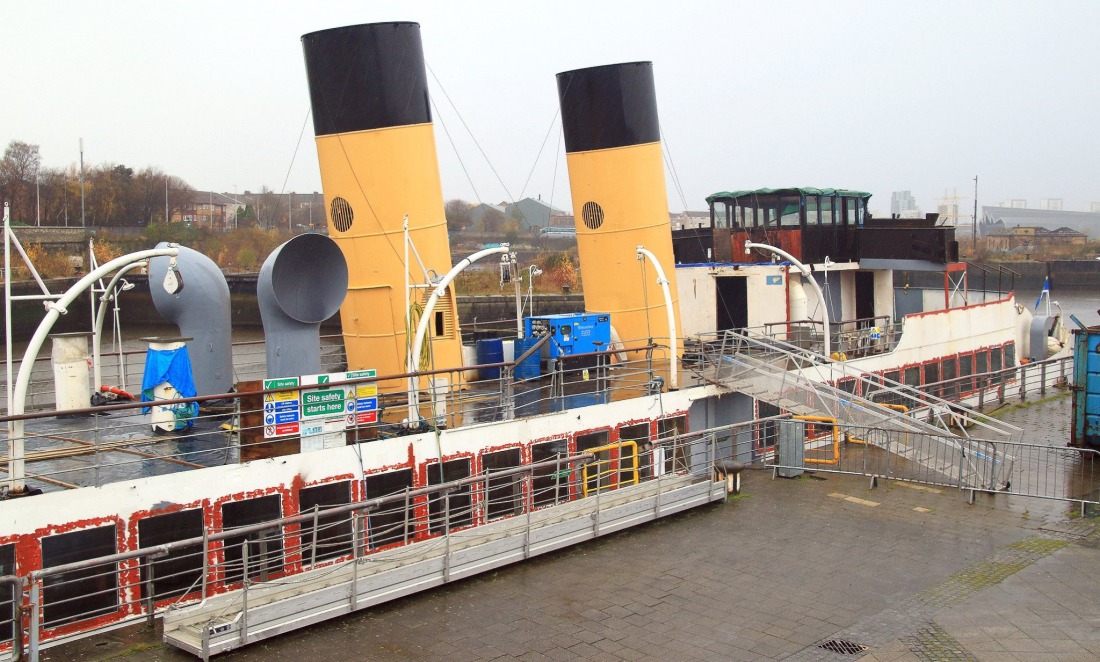
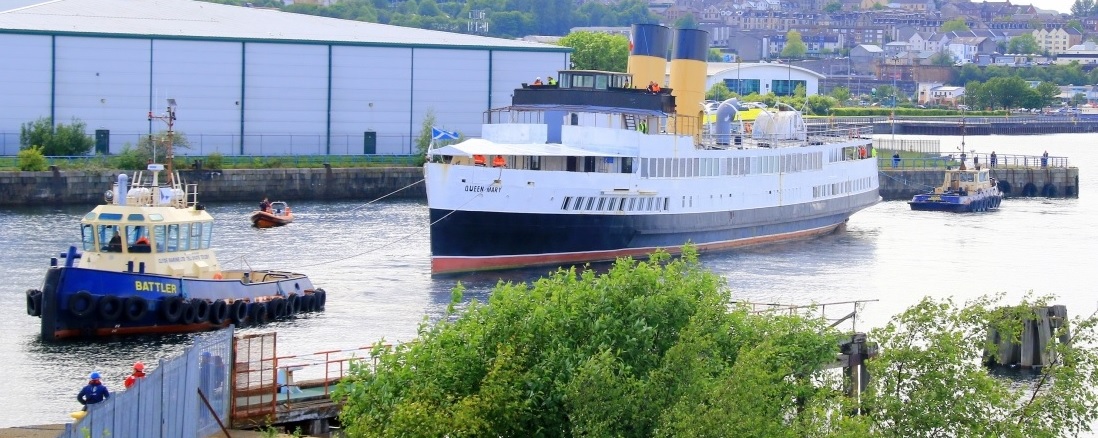
STEAM TURBINES
Turbines removed - two donated to the Science
Museum, London and one retained on the vessel and originally displayed in the
lower deck cocktail bar with a propellor directly attached.
Note :
One turbine
remains with the Science Museum and is held at their large item storage facility
at Wroughton, Wilts and can only be seen by appointment. Collection No. 1981-1562
One is now at the Scottish Maritime
Museum, Irvine and has been stored outside.
The webmaster is unclear about the current location of the third
turbine which was originally on display aboard on the lower deck but
was removed, probably during her 1997 refit
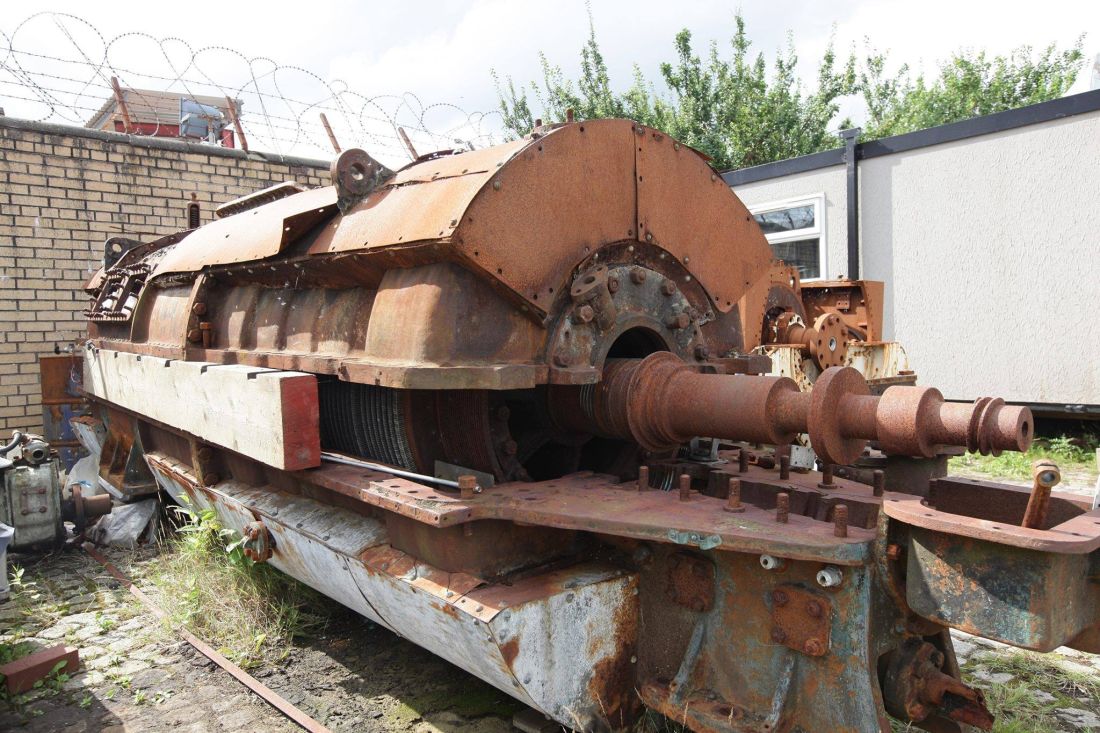
Above : Turbine outside the Scottish Maritime Museum, Irvine. Photo courtesy of Kenny Whyte
The turbine subsequently underwent conservation and restoration in 2019
BUILDERS' PLANS
26 of Denny's original ship plans
relating to yard Number 1262 are held in the archive of the National Maritime Museum,
Greenwich.
Click here for more
details regarding the specific plans available
Contact:
Manager, Historic Photographs and Ship Plans
Tel: +44 (0)20 8312 8600
Fax:
+44 (0)20 8317 0263
E-mail: plansandphotos@nmm.ac.uk
Ship Plans Website:
www.nmm.ac.uk/shipplans
QUEEN MARY'S CAPTAINS
1933-1943 Donald McKinnon
1944-1946 Fergus Murdoch
1946-1946 John McGlashan
1947-1954 James Ramsay
1955-1955 Walter Lennox
1956-1959 Mick Brophy
1960-1970 John Cameron
1971-1975 David McCormick
1976-1977 Callum MacLean
FURTHER INFORMATION
Entry in Lloyds Register for 1933-34
More about the ship's interesting connection with the famous Cunard ocean liner Queen Mary
Queen Mary's regular Clyde roster in the 1969 season
Examples of reports in the local press, 1977-1981
Vessel History Brochure by David Griffiths available on board in 1988
(pdf file)
(Rotate anti-clockwise for best viewing once pdf file is opened)
Many thanks to Martin Goldby for contributing this brochure
Details of offer for sale to the licensed trade as going concern through Colliers CRE in 2008
Text of Offers for Sale through Capital Boats : both in 2009 (at London) and 2011 (at Tilbury)
More about the project to establish her as a hotel and fitness centre at La Rochelle in France
The webmaster's 2011 press and TV awareness campaign
Tribute
to Ron Livett, Thames "waterman" and tugmaster - 2012
A view from the USA : Shawn Dake from California, submitted this
report of a trip on Queen Mary in 1977 to the magazine Steamboat Bill, the journal
of the Steamship Historical Society of America and it was published in winter,
1978. Shawn has since become a well-known author and campaigner on various matters
of maritime history and contributes articles regularly to the Maritime
Matters website amongst others. Many thanks to
Shawn for retrieving the article from the archive and allowing it to be reproduced
here. Click
to view as pdf file
BIBLIOGRAPHY
Aboard Queen Mary II : a Purser's Life on the Glasgow Boat
: by Richard Orr
ISBN-10: 1845300734
ISBN-13: 978-1845300739 First published 2011
http://www.amazon.co.uk/Aboard-Queen-Mary-II-Pursers/dp/1845300734/ref=sr_1_7?s=books&ie=UTF8&qid=1312409894&sr=1-7
Williamson-Buchanan Steamers / Williamson-Buchanan Steamers (1936) Ltd
Caledonian Steam Packet Company
MORE ABOUT CLYDE STEAMERS (Paddle Steamers and Turbine Steamers)
THE WEBMASTER
Gordon Stewart is (amongst other interests) a paddle steamer enthusiast and promotes paddle steamers through the paddlesteamers.info website
Gordon Stewart
can be contacted on this link
This is an unofficial website,
not connected in any way with past or present owners of the Queen Mary.
Any
views expressed are those of the webmaster only unless otherwise attributed.
All photographs displayed are with the permission of the acknowledged photographer
but are not to be copied for re-use for any other website or publication without
the specific authorisation of the photographer. You are welcome to use the text
from this website as a research source and basis for your own work but it should
not be copied and republished elsewhere verbatim or only slightly altered.
All
material is ![]() Gordon Stewart or the individual photographer where acknowledged.
Photos not otherwise attributed are by Gordon Stewart
Gordon Stewart or the individual photographer where acknowledged.
Photos not otherwise attributed are by Gordon Stewart
ASSOCIATED WEBSITES

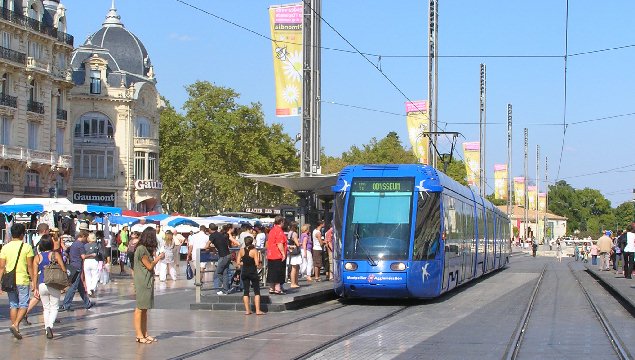
InTramCities with Gordon Stewart : Network Photography in Tramway Cities
Gordon Stewart travels regularly throughout Europe to create what is perhaps the finest tramway photograph resource on the internet. Although trams are the focal point and common thread throughout, it is where they are running which provides the diversity and interest in his photos. As well as city centres with their grand architecture, Gordon takes you to less well-known suburbs to give a real feel for the tramway city. The photos are becoming an important historical record for those interested in the city itself as well as its trams and also show how trams fit into urban environments to provide an attractive and accessible transportation system.
Return to